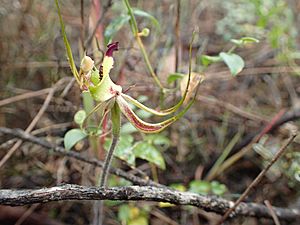Mantis orchids facts for kids
Quick facts for kids Mantis orchids |
|
|---|---|
 |
|
| Subspecies gracillima | |
| Scientific classification | |
| Genus: |
Caladenia
|
| Species: |
attingens
|
The Caladenia attingens, also known as mantis orchids, are special plants in the Orchid family. They are found only in the south-west part of Western Australia. There are three types, or subspecies, of these orchids. Each one has a single hairy leaf and one or two bright flowers. Their flowers have sepals that point upwards and a special lip (called a labellum) with long, comb-like fringes. The different subspecies vary in their size, where they grow, and their natural homes.
Contents
What Mantis Orchids Look Like
Mantis orchids are ground plants that live for many years (they are perennial). They are also deciduous, meaning their leaves fall off at certain times. These plants have an underground storage part called a tuber. They grow a single, hairy leaf that is about 5 to 20 centimeters (2 to 8 inches) long and 5 to 12 millimeters (0.2 to 0.5 inches) wide. The bottom part of the leaf often has reddish spots.
Each plant usually grows one or two flowers on a hairy stem that is about 12 to 45 centimeters (5 to 18 inches) tall. Each flower is about 4 to 8 centimeters (2 to 3 inches) long and 2 to 7 centimeters (0.8 to 2.8 inches) wide. The flowers are a mix of green, white, and yellow, with some reddish-purple areas.
The top part of the flower, called the dorsal sepal, stands upright. It is about 3.5 to 6 centimeters (1.4 to 2.4 inches) long and 1.5 to 3 millimeters (0.06 to 0.12 inches) wide. It often has a swollen, sticky tip. The side sepals are also long, about 3.5 to 6 centimeters (1.4 to 2.4 inches), and point upwards. They have a similar sticky tip. The petals are about 2 to 4 centimeters (0.8 to 1.6 inches) long and spread out wide. They usually don't have the sticky tip.
The labellum (the orchid's special lip) is greenish-yellow with a red tip. It has four or more rows of dark red bumps, called calli, along its middle. The sides of the labellum have long, green, comb-like teeth. Mantis orchids bloom, or flower, between August and November.
How Mantis Orchids Got Their Name
The scientific name Caladenia attingens was first officially described in 2001 by two scientists, Stephen Hopper and Andrew Brown. They published their description in a science journal called Nuytsia.
The word attingens comes from Latin and means "reaching to" or "attaining." This name was chosen because the red bumps (calli) on the labellum reach all the way to its tip.
When Hopper and Brown first described the species, they also identified two different types: C. attingens subsp. attingens and C. attingens subsp. gracillima. Later, Andrew Brown and Garry Brockman found and described a third type, which they named C. attingens subsp. effusa.
Where Mantis Orchids Live
Mantis orchids grow in Western Australia, in an area stretching from Perth all the way to Israelite Bay. The exact places they live and their preferred environments can be different for each subspecies.
Protecting Mantis Orchids
All three subspecies of Caladenia attingens are considered "Not Threatened" by the Western Australian Government's Department of Parks and Wildlife. This means they are not currently in danger of disappearing.

